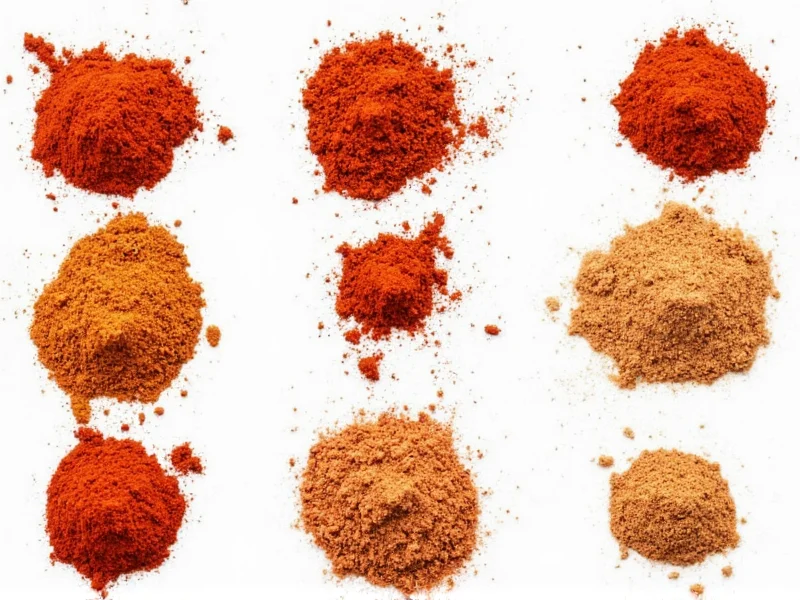Understanding whether can you substitute cayenne for chili powder requires knowing their fundamental differences. While both are red pepper spices, they're not interchangeable without adjustment. Chili powder is typically a blend of ground dried chilies (like ancho, cayenne, and others) mixed with complementary spices such as cumin, garlic powder, and oregano. Cayenne pepper, however, is a single-ingredient spice made from ground cayenne peppers, packing substantially more heat without the complex flavor notes of traditional chili powder.
Understanding the Key Differences
Before attempting any cayenne pepper substitute for chili powder conversion, recognize what sets these spices apart:
- Composition: Chili powder is usually a spice blend (20-40% cayenne plus other ingredients), while cayenne is pure ground cayenne pepper
- Heat level: Cayenne measures 30,000-50,000 Scoville Heat Units (SHU), while standard chili powder ranges from 1,000-3,000 SHU
- Flavor profile: Chili powder offers earthy, smoky, and slightly sweet notes; cayenne delivers straightforward heat with minimal complexity
- Usage: Chili powder works as a complete seasoning; cayenne functions primarily as a heat booster
Practical Substitution Guidelines
When considering can I use cayenne instead of chili powder in recipes, follow these evidence-based recommendations. The critical factor is respecting the significant heat differential while attempting to replicate chili powder's flavor complexity.
| Chili Powder Amount | Cayenne Equivalent | Recommended Flavor Boosters |
|---|---|---|
| 1 tablespoon | 1/4 teaspoon | 1/4 tsp cumin + 1/8 tsp garlic powder |
| 2 tablespoons | 1/2 teaspoon | 1/2 tsp cumin + 1/4 tsp garlic powder + pinch oregano |
| 1/4 cup | 1 teaspoon | 1 tsp cumin + 1/2 tsp garlic powder + 1/4 tsp oregano + pinch paprika |
When Substitution Works Best
Successful cayenne pepper to chili powder conversion depends on your specific recipe and desired outcome:
Ideal for: Soups, stews, and sauces where additional spices can be incorporated. The liquid base helps distribute heat evenly, and you can adjust seasoning as it cooks.
Problematic for: Dry rubs, spice blends, or dishes requiring precise flavor balance. Without liquid to mellow the heat, cayenne can dominate the flavor profile.
Professional chefs recommend adding the cayenne gradually, tasting after each addition. Remember that heat perception increases as a dish sits, so under-seasoning initially is preferable to overcompensating.
Creating a Better Substitute Blend
For more accurate chili powder substitute with cayenne, create a custom blend that mimics commercial chili powder's complexity. Combine these proportions in a small bowl before adding to your recipe:
- 1 part cayenne pepper (for heat)
- 3 parts paprika (for color and mild flavor)
- 1/2 part cumin (for earthiness)
- 1/4 part garlic powder (for depth)
- 1/4 part onion powder (for sweetness)
- Pinch of dried oregano (for herbal notes)
This blend addresses the fundamental issue with direct chili powder vs cayenne heat level substitution—it replicates both the heat and flavor complexity of standard chili powder. Store any extra blend in an airtight container for up to 3 months.
Recipe-Specific Considerations
Certain dishes require special attention when attempting substituting cayenne for chili powder ratio adjustments:
Taco seasoning: Use 1/4 tsp cayenne plus 1 tsp paprika, 1/2 tsp cumin, and 1/4 tsp each garlic powder and onion powder per tablespoon of chili powder called for.
Chili con carne: Start with 1/2 tsp cayenne for the first tablespoon of chili powder, then adjust with additional cumin and a touch of cocoa powder to maintain depth.
Marinades: Always dilute cayenne in oil or acid (like lime juice) before adding to prevent uneven heat distribution.
When to Choose Alternative Substitutes
Sometimes cayenne pepper substitute for chili powder isn't the optimal solution. Consider these alternatives when:
- You need mild heat: Use smoked paprika (1:1 ratio) for similar color without intense heat
- You want authentic flavor: Make your own chili powder blend using dried ancho, guajillo, and New Mexico chilies
- You're cooking for heat-sensitive individuals: Use sweet paprika with a pinch of cumin (1:1 ratio)
- You need immediate solution: Check your pantry for pre-made taco seasoning (use 1:1 but reduce added salt)
Remember that understanding how much cayenne equals chili powder is just the starting point—successful substitution requires balancing the entire flavor profile of your dish. The heat from cayenne develops more slowly than the immediate impact of commercial chili powder, so allow at least 15 minutes of cooking time after adding your substitute before final seasoning adjustments.











 浙公网安备
33010002000092号
浙公网安备
33010002000092号 浙B2-20120091-4
浙B2-20120091-4